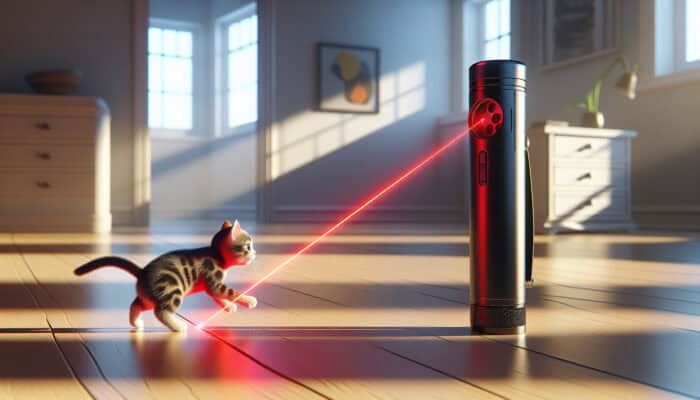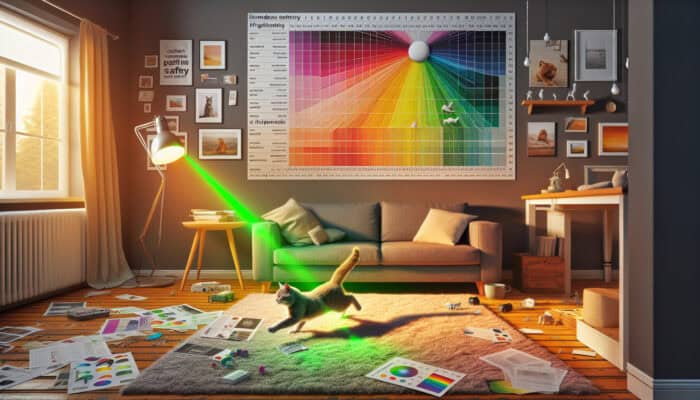The Comprehensive Guide to Laser Pointers and Feline Behaviour
Understanding the Functionality and Purpose of Laser Pointers

Laser pointers are compact, handheld devices engineered to emit a focused beam of light. These tools are not only popular in business presentations but also serve as stimulating toys for pets, particularly for cats. Cats are instinctively attracted to these light-projecting devices due to their inherent hunting instincts. However, it is crucial for pet owners to understand that improper usage of laser pointers can lead to serious health risks and emotional challenges for their feline friends. Here are the essential features of laser pointers that every responsible cat owner should be aware of:
- Compact and lightweight design, allowing for effortless handling.
- Available in various colours, with red and green being the most widely used.
- Low power output, although they can still pose dangers if misused.
- Provides immediate visual feedback, as the light moves swiftly and erratically, capturing attention.
- Operated by batteries, making them widely accessible and budget-friendly.
- Can create enjoyable and interactive play experiences for pets.
- May result in frustration for pets who are unable to catch the elusive light.
- Versatile for both feline play and human presentations.
Understanding these features is vital for cat owners seeking to engage their pets in a safe and responsible manner. While laser pointers can provide joy and entertainment, the potential risks necessitate a cautious and informed approach to their use.
The Impact of Laser Pointers on Cat Play Behaviour
Cats possess a well-developed prey drive, which makes them inherently curious and predisposed to chase small, moving objects. When a laser pointer beam zips across the floor or walls, it activates their hunting instincts, leading to playful pouncing and darting. While this behaviour can be entertaining for owners, it is essential to recognize that the experience may not always be advantageous for the cat.
Initially, cats may display excitement during the chase, exhibiting lively and playful behaviour. However, the lack of a tangible reward, such as a toy they can physically catch, can instil feelings of frustration and anxiety over time. This is particularly true for indoor cats, who often have limited opportunities for mental stimulation and physical exercise. Recognising these behavioural responses is crucial for any cat owner incorporating laser pointers into their pet’s play routine.
The Risks Associated with Laser Pointer Use in Cats
While laser pointers can provoke playful behaviour, several significant risks must be acknowledged by pet owners. A primary concern is the possibility of frustration and obsessive behaviour. Cats may become fixated on the moving light, leading to a repetitive cycle of chasing that ultimately fails to provide the satisfaction they crave. This fixation can heighten stress or anxiety, particularly for cats that are already predisposed to such feelings.
Beyond psychological implications, incorrect usage can result in physical hazards. Direct exposure to a laser’s beam can cause eye damage, potentially resulting in serious vision problems. Prolonged play sessions may also lead to overstimulation, contributing to hyperactivity or aggressive behaviour. Being aware of these dangers is essential for responsible cat owners, as the ultimate goal should always be to create a healthy, engaging, and safe environment for their feline companions.
Expert Recommendations for the Safe Use of Laser Pointers with Cats

Veterinary Guidance on Safe Laser Pointer Play
Veterinarians consistently stress the importance of exercising caution when using laser pointers in play sessions. They highlight the potential for stress and anxiety in cats as major concerns. Many professionals suggest avoiding laser pointers altogether due to the frustrations they can induce for pets, advocating instead for alternative toys that facilitate more fulfilling interactions. For those who wish to incorporate laser pointers into playtime, veterinarians offer specific strategies to mitigate associated risks.
One effective strategy is to ensure that play sessions conclude with the cat successfully catching a physical object, such as a toy mouse or a ball. This method not only satisfies their predatory instincts but also provides a fulfilling conclusion to the chase. Additionally, limiting the duration of laser pointer play can prevent overstimulation and frustration. Regularly engaging with alternative toys further reduces the dependency on laser pointers, fostering a more balanced play environment for the cat.
Strategies for Cat Owners to Integrate Laser Pointers Safely into Playtime
For cat owners who opt to incorporate laser pointers into their playtime activities, prioritising safety is essential. One effective strategy is to limit the duration of play sessions to no longer than 5 to 10 minutes to prevent overstimulation. It is equally important for owners to aim the laser pointers at surfaces that encourage physical play; when the session concludes, allowing the cat to catch a tangible object becomes crucial for providing closure.
Examples of safe laser pointer usage include alternating laser play with physical toys. For instance, after a brief session with the laser, owners can throw a toy for their cat to catch, creating a more rewarding and fulfilling experience. This practice minimises frustration while promoting physical activity, positively impacting the cat’s overall health. Monitoring the cat’s reactions throughout the play session is essential, enabling owners to adapt their approach based on their pet’s responses.
The Long-Term Effects of Regular Laser Pointer Use on Cats
Extended use of laser pointers can lead to significant behavioural challenges in cats. One concerning effect is the emergence of obsessive-compulsive behaviours. Cats may become overly fixated on the notion of the chase, experiencing heightened anxiety when they cannot catch the elusive light. This fixation can manifest in various forms, including excessive vocalisation, pacing, or other compulsive behaviours that disrupt their daily lives.
To effectively manage these long-term effects, it is crucial for owners to recognise the signs of distress and take proactive measures. Incorporating a variety of engaging activities and toys into a cat’s routine can help alleviate anxiety and provide consistent stimulation. Regular consultations with a veterinarian or animal behaviourist can also be beneficial, particularly if concerning behaviours persist. Addressing these issues proactively is essential for ensuring a cat remains content and healthy, with a suitable balance of play and stimulation.
Expert-Recommended Alternative Play Options to Laser Pointers
Experts advocate for a myriad of alternative toys and activities that engage cats without the risks associated with laser pointers. Interactive toys, such as feather wands and puzzle feeders, not only stimulate a cat’s natural hunting instincts but also promote both physical and mental engagement. These alternatives are specifically designed to satisfy the cat’s need for play while ensuring they experience a sense of accomplishment.
Specific recommendations for alternatives include:
- Interactive feather wands for dynamic physical play.
- Puzzle toys that dispense treats or kibble when solved for mental stimulation.
- Catnip-infused toys that entice engagement and play.
- Automated laser toys that allow the cat to catch the light intermittently.
- Scratching posts and climbing trees to encourage exploration and exercise.
- Ball toys that can be batted around for fun.
- DIY toys made from everyday materials for creative play.
- Laser toys designed to auto-shut off after a set duration for safety.
Utilising these alternatives not only minimises the risks of anxiety and frustration but also enhances the overall quality of life for cats. By engaging their minds and bodies through safe play options, owners can foster happier, more balanced pets.
Recognising Signs of Distress in Cats During Playtime
Identifying signs of distress in cats is vital for ensuring their well-being during playtime. Common indicators include excessive meowing, pacing, or hiding, which may suggest that the cat is feeling stressed or overwhelmed. Monitoring these signs provides valuable insight into the cat’s emotional state, allowing owners to adjust their play practices accordingly.
If a cat exhibits signs of distress during or after a laser pointer session, immediate action is necessary. Owners should pause the game and allow the cat time to calm down in a quiet environment. Engaging the cat in a different form of play or providing a safe space can help alleviate stress. Regularly checking in during playtime, along with monitoring behaviour after play sessions, ensures that the cat’s emotional needs are met, fostering a healthy and safe play environment.
Safe and Engaging Toy Alternatives for Cats
Identifying the Best Safe Toy Options for Cats
When selecting toys for cats, choosing safe options is critical to avoid the potential risks associated with laser pointers. Safe toys can provide cats with the essential mental and physical stimulation they crave. Options like interactive puzzles, feather wands, and catnip-filled toys stand out as excellent choices, engaging a cat’s instincts while ensuring their safety.
Interactive toys that require problem-solving allow cats to use their intelligence and dexterity to earn treats or rewards. Feather wands encourage active play and strengthen the bond between pet and owner, while catnip toys can evoke excitement and engagement without the stress of an unending chase. The key is to select toys that enable cats to feel accomplished and satisfied during play, thereby enhancing their overall well-being.
Techniques for Effectively Engaging Cats in Playtime
Engaging a cat in play involves more than simply tossing a toy across the room. Owners can enhance their cat’s playtime experience through diverse strategies designed to stimulate both body and mind. Regular play sessions that incorporate different types of toys can keep a cat entertained and active.
Some effective engagement strategies include:
- Setting aside dedicated playtime each day for consistent interaction.
- Rotating toys regularly to keep the experience fresh and exciting.
- Incorporating training sessions with rewards to stimulate learning.
- Creating an enriched environment with climbing structures for exploration.
- Engaging in interactive play with another pet for social interaction.
- Introducing DIY toys made from safe household materials for creativity.
- Utilising treat-dispensing toys to encourage play and motivation.
- Establishing a schedule for playtime to create a routine.
By implementing these strategies, owners can create a stimulating and rewarding environment, allowing their cats to thrive both mentally and physically. This approach not only promotes happiness but also strengthens the bond between pet and owner, enriching the feline’s overall life experience.
Understanding the Advantages of Using Alternative Toys for Cats
The benefits of utilising alternative toys over laser pointers are substantial and varied. Engaging toys contribute to a cat’s physical health, mental well-being, and emotional stability. By providing a diverse range of interactive experiences, cat owners can significantly reduce the risks associated with frustrating play sessions that typically arise from laser pointer use.
Moreover, toys that require physical interaction promote exercise, helping to combat obesity and associated health problems. Mentally stimulating toys encourage cognitive development, preventing boredom that can lead to destructive behaviours. Ultimately, the benefits of alternative toys extend beyond mere entertainment; they enrich a cat’s life, fostering happiness and satisfaction while supporting a healthier lifestyle.
Strategies for Transitioning Cats from Laser Pointers to Alternative Toys
Transitioning a cat from laser pointers to engaging with alternative toys necessitates a thoughtful and gradual approach. This process should be slow, allowing the cat to adapt to new types of play without causing additional stress. Begin by introducing one or two alternative toys during playtime while gradually phasing out laser pointer sessions.
Positive reinforcement plays a crucial role in this transition. Rewarding the cat with treats or affection when they engage with the new toys can encourage continued interaction. Observing their preferences and gradually introducing a variety of choices ensures that the cat remains engaged and interested. By creating a supportive and enriching environment, owners can effectively shift their cat’s play habits while promoting overall well-being.
Recognising Signs of Overstimulation in Cats
Key Indicators of Overstimulation in Cats
Overstimulation in cats can manifest in various forms, often leading to behavioural issues that require attention and intervention. Symptoms such as excessive meowing, aggressive behaviour, and hyperactivity may arise, signalling that a cat has reached its limit during playtime. Understanding these symptoms is crucial for any cat owner aiming to maintain their feline’s well-being and happiness.
For instance, excessive vocalisation can indicate that a cat is feeling overwhelmed or frustrated, while aggressive behaviours (such as swatting or biting) may signal anxiety. Hyperactivity might present itself as frantic running or excessive jumping, indicating that the cat is struggling to regulate its excitement. Recognising these signs early enables owners to intervene and provide the necessary calm and safe environment that their cat needs to feel secure.
Preventing Overstimulation in Cats During Playtime
Preventing overstimulation requires a proactive approach to playtime and environmental management. Owners should limit play sessions to specific durations, generally not exceeding 10 to 15 minutes, to prevent overwhelming the cat. Incorporating calming aids, such as pheromone diffusers, can help create a soothing atmosphere during playtime.
Additionally, providing a quiet space for the cat to retreat to when feeling overstimulated is vital. This could be a comfortable bed or a designated room where the cat can relax undisturbed. Establishing a routine around playtime helps cats become accustomed to their activities, reducing anxiety and the likelihood of overstimulation. By fostering a calm and enriching environment, owners can significantly mitigate the risk of overstimulation and its associated behaviours.
When to Seek Professional Help for Overstimulated Cats
If a cat exhibits persistent signs of overstimulation or stress, it is crucial for owners to seek professional guidance. Consulting a veterinarian or a certified animal behaviourist can provide valuable insights and tailored strategies to address the individual cat’s needs. Ongoing anxiety may not only disrupt playtime but can also lead to serious health issues if left unaddressed.
Professional guidance can assist in developing a customised plan to manage the cat’s behaviour, ensuring that the animal’s emotional and physical well-being is prioritised. Early intervention is key; the sooner concerns are addressed, the greater the chances for a successful outcome. By providing a safe and healthy environment for cats, owners can promote a fulfilling quality of life and foster a strong bond between pet and owner.
Effective Strategies for Laser Pointer Safety with Cats
Practical Safety Measures for Laser Pointer Use
Implementing effective safety measures is crucial for cat owners who choose to use laser pointers during playtime. One of the most critical strategies is to use laser pointers sparingly, ensuring they do not become the primary source of stimulation. This approach helps prevent the onset of obsessive behaviours and anxiety in cats, promoting a healthier play experience overall.
Another significant safety measure is to conclude laser play sessions with a tangible object, such as a toy or treat. This practice allows the cat to enjoy a sense of accomplishment, which is vital for their emotional health. Closely monitoring the cat’s behaviour during and after playtime can also help identify any signs of distress or frustration, enabling owners to make timely adjustments as needed. Adhering to these expert-backed strategies not only enhances safety but also enriches the overall play experience for cats.
Monitoring Cat Behaviour During Playtime
Effectively monitoring a cat’s behaviour during playtime is paramount for ensuring its well-being. Owners should observe their cat’s reactions closely, watching for signs of frustration, anxiety, or overstimulation. This involves not only watching for behavioural changes during play but also assessing the cat’s overall demeanour after playtime.
If owners notice that their cat becomes increasingly agitated or aggressive, it may be necessary to pause the play session. Keeping a detailed record of the cat’s behaviour can also assist in identifying patterns, allowing owners to tailor their playtime strategies accordingly. By being attentive and responsive, owners can create a positive play environment and address potential issues before they escalate.
Best Practices for Responsible Use of Laser Pointers
Adopting best practices for laser pointer use can significantly reduce the associated risks while enhancing playtime for cats. One key practice is to reserve laser pointers for occasional use, ensuring they are not the sole source of entertainment. This helps mitigate the potential for frustration linked to chasing an uncatchable light.
Moreover, it is crucial to avoid aiming the laser directly into a cat’s eyes, as this can cause serious eye damage. Instead, directing the laser at surfaces like the floor or walls encourages safe play while still engaging the cat’s instincts. An effective practice is to combine laser pointer play with physical toys, allowing the cat to seamlessly transition between the two forms of play. By implementing these best practices, owners can create a safe, enjoyable, and enriching play experience for their feline friends.
Risks Associated with Excessive Use of Laser Pointers
Excessive use of laser pointers can lead to various negative effects on a cat’s behaviour and emotional state. One of the main risks is the development of obsessive behaviours, where the cat becomes fixated on the light and struggles to disengage. This obsession can result in heightened anxiety, leading to destructive behaviours or excessive vocalisation.
Additionally, overuse can lead to potential eye damage if the laser is pointed directly at the cat’s eyes. Owners should remain vigilant for signs of overuse, such as constant meowing, pacing, or aggressive behaviour. Establishing clear boundaries around laser pointer playtime and ensuring a balanced mix of alternative toys can help prevent these negative outcomes, promoting a healthier play environment for cats.
Raising Awareness About Laser Pointer Safety
Educating Family Members on Laser Pointer Safety
Educating family members about the risks linked to laser pointers is vital for a cat’s safety and well-being. Owners can initiate discussions to explain the potential dangers, such as frustration and overstimulation, while emphasising the importance of responsible play practices. Demonstrating safe alternatives, like interactive toys, can also provide insight into effective ways to engage with the cat without the risks associated with laser pointers.
Creating a family plan for playtime that incorporates everyone’s understanding can foster a collective approach to pet care. This ensures that all members of the household prioritise the cat’s well-being and engage in safe play practices. By promoting open communication and shared knowledge, families can work together to create a nurturing environment for their feline friends.
Resources for Educating Pet Owners on Laser Pointer Safety
A plethora of resources is available to help educate pet owners about laser pointer safety. Veterinary advice, online articles, and educational videos serve as excellent starting points for understanding the risks and best practices related to laser pointer use. Many veterinary clinics offer brochures or workshops on pet safety, which include discussions on proper toy use and the importance of mental stimulation.
Online platforms and pet care organisations also provide valuable information, including expert opinions and real-world case studies. Engaging with these resources empowers cat owners to make informed decisions regarding their pets’ play and overall well-being. The more educated an owner is, the better equipped they will be to ensure a safe and fulfilling environment for their cats.
The Importance of Raising Awareness About Laser Pointer Safety
Raising awareness about laser pointer safety is crucial to preventing harm to cats globally. By sharing knowledge of the risks and advocating for responsible pet ownership, communities can cultivate environments that prioritise animal welfare. Informed pet owners are more likely to choose safer alternatives, significantly reducing the chances of psychological and physical health issues in cats.
Moreover, awareness initiatives can foster a sense of community among pet owners, encouraging them to share their experiences and solutions. Group discussions, workshops, or social media campaigns can amplify the message, reaching a broader audience and enhancing the dialogue around responsible pet care. This collective effort can lead to a more informed public, ultimately benefiting the health and happiness of pets everywhere.
Contributions of Schools and Community Centers to Education Efforts on Laser Pointer Safety
Schools and community centres play a vital role in educating the public about laser pointer safety and animal welfare. By hosting workshops and informational sessions, these organisations can engage local communities in discussions about responsible pet ownership. Topics may include the risks associated with laser pointer use, alternative toys, and behavioural signs to watch for in pets.
Additionally, incorporating animal welfare education into school curriculums can instil a sense of responsibility in future generations. Engaging students through interactive activities, such as inviting local veterinarians to speak or organising pet care projects, can enhance understanding and appreciation for animal safety. This proactive approach helps cultivate a culture of empathy and responsibility toward pets within communities.
The Role of Social Media in Spreading Awareness About Laser Pointer Safety
Social media platforms serve as powerful tools for disseminating educational content related to laser pointer safety and animal welfare. By sharing informative articles, infographics, and videos, pet owners can reach a wider audience and foster discussions on safe play practices. Engaging with communities on platforms like Facebook, Instagram, and Twitter can amplify the message and raise awareness about responsible pet care.
Moreover, social media enables pet owners to share their experiences, seek advice, and discuss best practices with one another. This collaborative information-sharing can create a supportive network of pet owners dedicated to improving the well-being of their animals. The potential for viral content significantly enhances the reach of crucial safety messages, making social media an essential ally in spreading awareness and education.
Frequently Asked Questions About Laser Pointer Safety for Cats
Are laser pointers safe for cats when used responsibly?
Laser pointers can be safe when utilized with care and moderation. However, they may lead to frustration and compulsive behaviours if misused. Making sure your cat can catch a physical object at the end of a session can help mitigate some risks.
What are the signs indicating my cat is overstimulated?
Signs of overstimulation in cats can include excessive vocalisation, aggressive behaviours, pacing, and hiding. Monitoring your cat during play will assist you in recognising these signs early.
What alternative toys can I use instead of laser pointers?
Alternatives to laser pointers include interactive toys, feather wands, puzzle feeders, and catnip toys. These provide safe and engaging options for play that fulfil a cat’s natural instincts.
How long should laser pointer play sessions last for optimal safety?
Laser pointer sessions should generally last no longer than 5 to 10 minutes to prevent overstimulation and frustration. Always conclude with a tangible toy to give your cat a chance to catch something rewarding.
What steps should I take if my cat shows signs of distress during play?
If your cat exhibits signs of distress, such as aggression or excessive meowing, cease the play session immediately. Provide a calm and quiet space for your cat to relax before engaging in further play.
How often should I engage in play sessions with my cat?
Regular play sessions—ideally daily—are essential for a cat’s physical and mental health. Aim for several short sessions throughout the day, incorporating a variety of toys to maintain interest.
Can laser pointers cause damage to my cat’s eyes?
Yes, shining a laser pointer directly into a cat’s eyes can result in significant damage. Always avoid aiming the laser at your cat’s face or eyes during playtime.
How can I determine if my cat is happy during playtime?
Signs of a happy cat during play include purring, relaxed body language, playful behaviour, and engagement with toys. A content cat will often appear curious and enthusiastic about playtime.
Are there specific toys that are particularly effective for mental stimulation?
Indeed! Toys that encourage problem-solving, such as puzzle feeders, interactive wands, and treat-dispensing toys, are excellent for mental stimulation. Regularly rotating these toys keeps your cat engaged and interested.
What actions should I take if my cat develops obsessive behaviours?
If your cat exhibits obsessive behaviours, consult a veterinarian or animal behaviourist. They can help formulate a tailored plan to address the behaviour and suggest safe alternative activities.
Connect with us on Facebook for more updates!
The Article Laser Pointer Safety For Cats: Essential Tips First Published On https://elgatoencasa.com
The Article Laser Pointer Safety Tips for Cats: Essential Guidelines Was Found On https://limitsofstrategy.com



